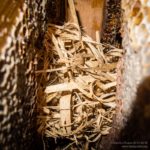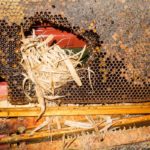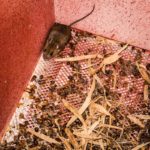I hate those meeces to pieces

Mr. Jinks and Pixie & Dixie
Like Mr. Jinks “I hate those meeces to pieces”. Mr. Jinks was talking about Pixie and Dixie, whereas I think my troubles were caused by wood mice (see photo on the right below). I checked some colonies last weekend and one of the nucs was suspiciously quiet. Upon further inspection it was clear that a family of mice had taken up residence and destroyed the colony. This is my first winter loss to rodents since I started beekeeping … and it’s my own fault. My standard, so-called ‘kewl’, floors are mouse resistant – they have an L-shaped entrance tunnel that is too narrow for a mouse to get through. I’ve used these for several years and, consequently, pretty much ignored the need for mouseguards. I’ve also overwintered many poly nucs over the last few seasons and never had an issue with rodents. Maybe I’ve just been lucky. Whatever the reason, the combination of no previous problems coupled with misplacing lots of my little-used (“When did I buy that?” and “I never knew I owned one of those”) beekeeping paraphernalia during the move to Scotland meant that I didn’t put mouseguards on any of the Everynuc poly nucs in my apiaries. These nucs have a cavernous entrance, just about the only poor design feature of these hives in my opinion.
- Cosy
- Loads of stores
- Smelly carnage
- Grrrr!
I sublimated these colonies with oxalic acid (OA) on the 9th of December and had checked the removable tray a few days later … there were few if any mites, but also very little hive detritus (legs, cappings, pollen etc.). However, it was a filthy wet day (again) and I didn’t have a veil or gloves with me so left them to it. I suspect the mice moved in shortly after the nuc was treated with OA (or they’re a lot less affected by vaporised OA than beekeepers are), leaving them nearly three weeks to wreak carnage in, what was, a very strong nuc. I’ve now found the mouseguards and fitted them to the remaining nucs … better late than never.
More winter troublemakers

Woody Woodpecker
While we’re on the subject of hives receiving unwanted attention in the winter it’s worth remembering Woody Woodpecker. Green woodpeckers – these, not the greater or lesser spotted woodpeckers, are the ones to be concerned about – are scarce and locally distributed in Scotland, though they are spreading slowly North-East according to the British Trust for Ornithology. I’ve yet to see one in Fife. I’ve therefore not bothered wrapping my colonies in damp proof membrane or taken more drastic measures with yards of chicken wire and bamboo canes. Woodpeckers generally only damage hives when the weather is really cold, conditions we have yet to experience this winter. I’m also told it’s learned behaviour and, as green woodpeckers are usually resident, some apiaries can experience problems while others, just a few miles away, escape unscathed. If they are about and they have learned what easy-pickings are available in a hive you’d be advised to protect them – a woodpecker can quickly get through a cedar hive and usually targets the handholds of poly hives (often the thinnest part of the sidewall) though these are easy to repair.

Don’t let them get comfortable in your hive




Join the discussion ...